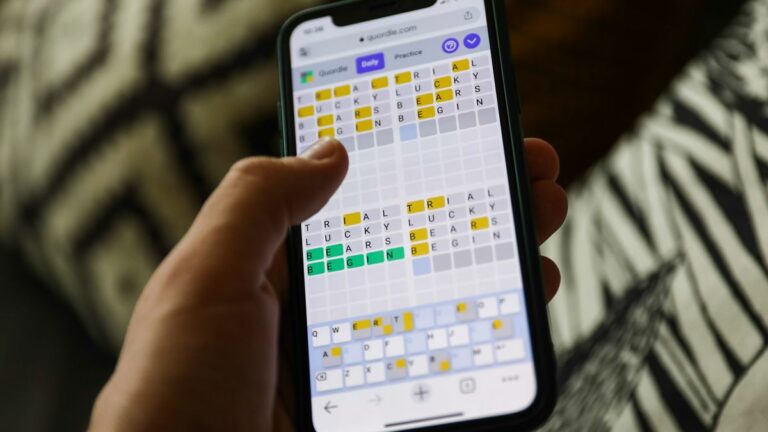
Pros
- Built-in KVM switch and okay bundled webcam
- Color accuracy isn’t bad for the price
- Vertical orientation good if you read a lot of documents
Cons
- Some connectors blocked by the stand
- Dim
- OSD options aren’t customized for the monitor’s capabilities
- Webcam may be too high for shorter people because of the monitor’s vertical height
Why rely on two monitors to do what you can get done with just one? That’s the question LG first tried to answer with its DualUp monitor, a quirky display that effectively fits two small 1440-pixel monitors on top of each other with no seam separating them. Now Innocn is answering another question: What if you could get the LG DualUp monitor for substantially less money? The Innocn 28C1Q doesn’t have a splashy name, but it features the same gimmick, offering a 28-inch display with a 16:18 aspect ratio at the same 2560×2880-pixel resolution that LG offers.
So what’s the catch? The truth is there really isn’t much of one. The fit and finish of the Innocn 28C1Q isn’t dazzling, and it makes a couple of downright foolish design mistakes, like having video ports that point straight out that back where they mash right up against the stand. It’s also not an exceptional display panel, but it’s not bad. Innocn has even packed in a few extra utilities to make the monitor provide extra value beyond its low price tag. I wouldn’t recommend it for anything beyond general-purpose work, but in that realm, it might find a few eager buyers.
Innocn 28C1Q
| Price | $400 |
|---|---|
| Size (diagonal) | 27.6 in/71 cm |
| Panel type | Nano IPS |
| Flat or curved | Flat |
| Resolution and pixel density | 2,560 x 2,880, 139 ppi |
| Aspect ratio | 16:18 |
| Maximum gamut | 96% DCI-P3 |
| Brightness (nits, peak/typical) | 300/300 |
| HDR | HDR10 |
| Adaptive sync | None |
| Max vertical refresh rate | 60Hz |
| Connections | 2x HDMI 2.1, 1x DP1.4, 1x USB-C (90W PD, video input), 2x USB-A, 1x USB-B upstream, 1x USB-C Webcam, 1x RJ45 |
| Audio | Headphone jack, stereo speakers |
| VESA mountable | Yes |
| Panel warranty | 30-day return; 1 year limited parts and labor |
| Release date | February 2023 |
The monitor’s vertical orientation and sharp image make it a good match for that. Throughout my testing, I found it easy to squeeze four windows onto the screen (or two small windows and one widescreen window) to get a lot of information on the screen at once. Even while writing this review, that abundance of workspace proved helpful, although you could also get more space from a 32-inch 4K monitor or 34-inch ultrawide. It can also work simultaneously with multiple systems, connecting a desktop and laptop, for example, splitting the screen down the middle or running one in a picture-in-picture window.
The Innocn 28C1Q features a USB-B port to connect the hub functions to the computer, as well as a USB-C port with 95-watt power delivery that can serve as a display input option. It also has a pair of USB-A ports to let it serve as a hub for connected systems, and it offers KVM switch capabilities. Hub/KVM features aren’t common on budget displays, and it’s a set of features to include on a dual-system monitor. By default, the KVM switch is a little buried in the settings, but it can be set as a hotkey shortcut for quicker access.

A few of the connectors are blocked by the stand.
Further adding to the pot, Innocn has a USB-C port on the top edge of the monitor where a bundled webcam slots in. The 1080p webcam’s not even half bad, with a wide viewing angle and relatively sharp visuals that help make up for the awkwardly high placement. The camera tilts to help get a better angle or face down for privacy.
Innocn even packed in a set of speakers that push out an impressive level of volume. They sound a bit boxed in and aren’t pleasant for music or long-term listening, but they’re intended for videoconferencing and can provide usable audio in a pinch.
For mainstream work, not play
For productivity-type uses, the Innocn 28C1Q doesn’t have to do too much for visuals: Its sharpness is perhaps its best attribute in that respect.
By default, Innocn has enabled the ambient light sensor, which can result in the brightness set way too low. In my case, that meant 49 nits with a pitiful 680:1 contrast ratio. It just looks bad, and there’s little reason for it beyond potential power savings. On a desktop monitor, it makes little sense, unless you have direct sunlight on the screen. Otherwise, the ambient light doesn’t change a lot.
Cranking the brightness up to 100% makes a big difference, increasing it to 306 nits. It covers 100% of the sRGB gamut at all brightness levels and hit 95% P3 coverage in our peak brightness testing. 300 nits is still a bit dim, but usable in an office environment, especially with the anti-glare finish. Contrast only reaches 910:1, on the low side for an IPS display, because the blacks aren’t very dark.
Color measurements
| Profile | Gamut (% coverage) | White point | Gamma | Typical brightness (nits) | Contrast | Accuracy (delta E 1976 average/max) |
|---|---|---|---|---|---|---|
| Standard (100% brightness) | 100% (sRGB) | 7400K | 2.4 | 306 | 910:1 | 1.6/3.26 |
| P3 | 95% (P3) | 6800K | 2.2 | 323 | 960:1 | 0.87/2.46 |
It has decent color accuracy, measuring an average of 1.6 dE 1976 and a max of 3.26. You probably won’t want to do design or other graphics work on the display, but at least the colors won’t be grossly inaccurate while shopping online. It does better in P3 color mode. Brightness and contrast get a boost, reaching 323 nits and 960:1. Factor in the more comfortable 6800K white point and accurate 2.2 gamma curve, plus improvements to color accuracy, and you’re probably better off using P3 instead of the default mode.
HDR mode measurements
| Preset | Gamut (% P3) | White point | Full screen brightness (nits) | 10% APL brightness | Black level (nits) |
|---|---|---|---|---|---|
| HDR Standard | 95 | 6690K | 328 | 328 | 0.34 |
| HDR Movie | 96 | 6670K | 278 | 279 | 0.28 |
| HDR Design | 95 | 6625K | 199 | 298 | 0.20 |
The Innocn 28C1Q supports HDR, but like most monitors at or under $400, it doesn’t do much beyond mapping the HDR signal it receives to the minimal capabilities of the monitor. Activating any of the three HDR picture modes fails to provide a meaningful increase in brightness, contrast or color gamut. Even enabling HDR is a little tedious because it has to be enabled manually on both the monitor and the connected system. Since the display also has an odd aspect ratio, it’s not well set up to enjoy a lot of content where HDR would matter anyway.
Game mode measurements
| Preset | White point | Gamma | Brightness (nits) |
|---|---|---|---|
| FPS | 9000K | 2.4 | 264 |
| RTS/RPG | 6800K | 2.4 | 333 |
| MOBA | 7200K | 2.4 | 316 |
Just as it’s not built for media consumption, the Innocn 28C1Q isn’t well suited to gaming either, thanks to its odd aspect ratio, low contrast and 60Hz refresh rate (with no VRR solution). Its pixel response time isn’t bad, with only short ghosting trails behind moving objects in Blur Busters’s UFO test, but it’s still not great. Still, Innocn includes a few gaming modes for the monitor, identical to those we saw on the Innocn 40C1R.
It makes for a fine office display, offering surprising versatility that many lack for a relatively low price, but it probably won’t be the best monitor for anyone who isn’t absolutely sold on the special aspect ratio.
How we test monitors
Measurements for the Innocn 28C1Q were taken using a SpyderX Elite colorimeter using DataColor’s SpyderX Elite software for SDR. Color accuracy measurement results are reported in Delta E 1976 using Datacolor’s 48-color patch test.
In addition, HDR results were gathered using the VESA DisplayHDR Test app’s patterns to display 100% and 10% windows for brightness measurements as well as RGBW values, again measured using the SpyderX Elite, to get CIE xyY color values and compared against the DCI-P3 color space’s xyY color values to calculate HDR gamut coverage using this gamut calculator.
We also used Blur Busters’ motion tests to judge motion artifacts (such as ghosting) or refresh rate-related problems that can affect gaming.
Keep in mind that individual results can vary from a manufacturer’s reported results for a lot of reasons, such as different color patch sets, colorimeters, delta E calculations, settings and a lot more.




















+ There are no comments
Add yours